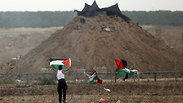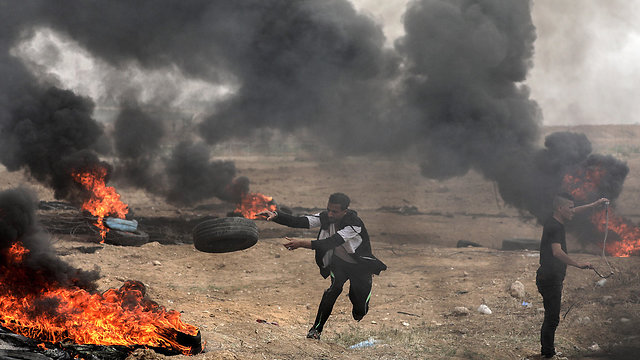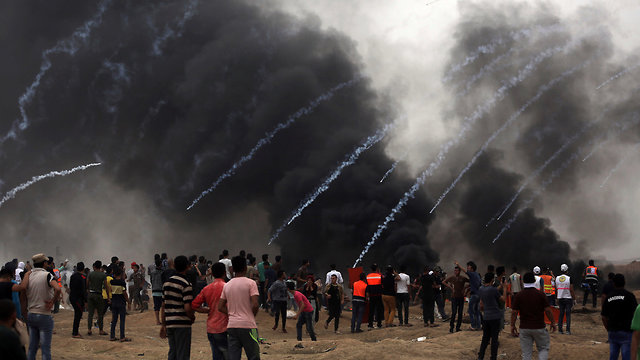

It isn't too late to stop Gaza insanity
Op-ed: Seeing next week’s escalation in the strip as inevitable, Israel and Hamas are busy calculating the expected death toll from the border riots. An Israeli willingness to give a dialogue a chance may be the only way to stop what will likely turn into the next war in the strip.
This body discourse sounds insane, but both sides are approaching this collision with their eyes open. These numbers definitely don’t sound baseless to those who saw young Palestinians running amok on Friday towards the Palestinian side of Kerem Shalom, and saw the fire, the plunder, the look of murder in their eyes. Even Hamas has lost control over these people.
And the calculations continue: Hamas believes that at the height of the clashes—Nakba Day and the opening of the US embassy in Jerusalem—the organization will manage to recruit hundreds of thousands of people to storm the fences. Israel believes that despite the Palestinian efforts, Hamas won’t be able to recruit more than 100,000 people.
In last Friday’s clashes, despite the violent riots and the attempts to breach the fence in several places, not a single Palestinian was killed. That’s no coincidence. The army is doing its utmost to reduce the number of casualties from live fire, excluding radical cases.
This may not sound convincing in light of the killing of three Palestinians in the southern strip on Sunday after a terrorist cell tried to infiltrate the fence and damage security infrastructure nearby. Nevertheless, the fact is that after nearly two months of provocations and sabotage every single weekend, the army is practicing restraint.
Each group of snipers is supervised by a regiment commander, who is the only one to approve any shooting. Every fired bullet is listed. Every bullet that inflicts an injury beyond the legs is investigated by the Gaza Division commander, Brig. Gen. Yehuda Fuchs, who personally briefs the snipers. The Sniper School instructors—mainly female instructors, by the way—are with the snipers to solve professional problems. The experience gained in the past few weeks has led to a drop in the number of casualties.
Everyone is preparing for next week’s explosion as if it’s an inevitable predestination. The defense establishment is dealing with “the day after” May 15. The army is outlining two possible scenarios. In the first scenario, the number of casualties on the Palestinian side creates a situation in which the Hamas leadership is no longer willing or able to restrain the military wing, and a military conflict erupts, possibly leading turn into another war in the strip.
The second scenario is that after the May 15 explosion, which seems inevitable by now, a diplomatic-economic initiative will emerge to solve the siege issue. This will mainly be an implementation of the plan initiated by the former coordinator of the government’s activities in the territories, with the government’s blessing, which enlists a group of countries that are already willing to carry out unprecedented water, sewage and electricity infrastructure projects in the strip. The flow of funds will provide the strip’s residents with an occupation solution and a ray of hope for the future.
This plan is stuck because of Palestinian President Mahmoud Abbas’ objection. At the end of his political career, the elderly Palestinian leader has decided that if he can’t implement the Palestinian state vision, he’ll just let Israel and Hamas burn each other.
Up until today, the entire Gaza reconstruction process has gone through a system connected to the international institutions and the Palestinian Authority. The European countries and the United States are incapable of working directly vis-à-vis Hamas in the strip, as long as Abbas is in charge.

The Israeli government must make a critical decision: Should it allow an investment of hundreds of millions of dollars in humanitarian activity in the strip, through systems overriding the PA. This government doesn’t seem capable of reaching such a decision. While the Europeans understand the obstacles placed by Abbas and are threatening to go around him eventually, they need Israel’s cooperation.
There is a solution for all this insanity. Hamas keeps relaying messages to the defense establishment that it’s still interested in a “hudna.” The Hamas leadership is made up of different streams, and the stream pushing for a hudna is represented by elected leader Yahya Sinwar.
There are different assumptions about the meaning of this hudna. Hamas itself has conveyed to Israel in the past year different versions of a restricted or wider hudna, which include not only Gaza but the West Bank as well. These demands and conditions have never been discussed, as Israel refuses to talk to Hamas. The Egyptians, however, are willing to talk.
It may be time to go around the Palestinian Authority and give a dialogue a chance. This may be the only way to stop what looks like the next war in the strip.

















